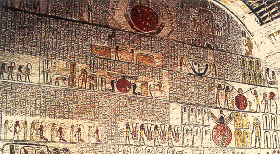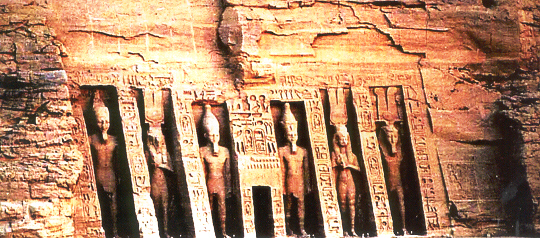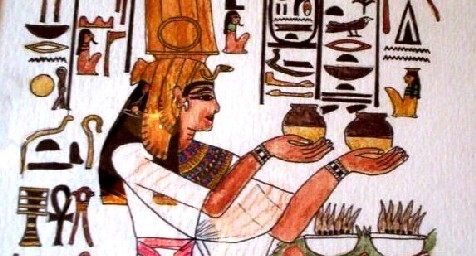|
The
archeologists excavating the remains of the civilization
of the Nile Valley Delta believe that man had inhabited
the area and the surrounding deserts ever since the Ice
Ages. However, the Ice Age did not extend to North
Africa, which made it possible for people to settle down
on the banks of the Nile River building their mud huts
made up of poles, intertwined with twigs, reeds,
branches and straw. The stone implements left by these
early people make the archeologists believe that they
were probably hunters who made up the colonies of early
settlements and they were probably originating from
different parts of the Mediterranean Region. They used
weapons, which were made up of beautifully fashioned
flints. However, the origins of the early Egyptians will
remain a puzzle to the historians to this day.

The early people were probably living in agricultural
communities who cultivated the lands of the banks of the
River Nile after the rainy season, which made the soil
around the Delta fit for cultivation. By 7000 BCE, it is
assumed, there was a push of various tribes into the
fertile Valley from the Asiatic east, who joined the
existing settlements, as the valley was green, forested,
peopled, and rich in animal life. They brought with them
various cattle to cultivate the lands, and raised goats,
sheep and kept duck and geese. Asses were used as beasts
of burden. The ornaments – discovered by archeologists –
were made up of ivory and shell. There is evidence to
suggest that these people used rogue and malachite as
paint. They designed beautiful pottery and invented the
use of glazes. Above all, they invented writing –
writing at first primitive and pictographic – and later
developed into hieroglyphics on one hand, and a phonetic
system on the other.
Even then, the early Egyptians carried a lucrative trade
with other countries in the Mediterranean region and
along the coasts of the North African continent. The
early ships designed by them were about one hundred feet
long and were sometimes manned by as many as sixty
oarsmen. Painted on the cabins of their ships were
emblems of their homeport, which was an elephant,
crescent, a fish etc.
During the Bronze Age – about 6000 BCE – it is believed
that the Nile Valley Civilization came under the rule of
Kings. Stone was used by the third dynasty for the first
time in the place of bricks. King Djoser of Egypt was
the first person to construct a step pyramid, as his
tomb, with temples and palaces and Chapel near the area
of Saqqara.
By this time, the famed riches of the Egypt had
attracted the attention of King Menes of Thinis, who
invaded Egypt probably crossing the Red Sea. The history
claims that he was the first among the kings of Egypt
who was responsible for unifying the Upper and Lower
Egypt under his rule. He successfully defeated the
Libyans and during his time – 3500 to 2900 BCE – the
Egyptian army had extended its rule into the neighboring
Nubian Kingdom and expanded to the First Cataract of the
River Nile. Menes also founded the City of Memphis, and
chose its location on an island on the River Nile – a
site located twenty miles away from Cairo - so that it
would be easy to defend against an enemy attack. He was
also the founder of a city called Crocodopolis.
During the Old Kingdom of Egypt, estimated to have
started from 2686 – 2181 BCE, the Great Pyramids of
Egypt were built. Death, the Egyptians believed, was a
continuation of life, which is the reason they spent so
much time and effort in preparing for it. The great
stones for these pyramids were quarried from the Western
side of the River Nile, often far from the building site
and were towed on rafts across the river – a very
delicate act of navigation – that made the task
difficult because of the strong flood currents of the
river. The stones, which were shaped in the form of
squares, weighed as much as ten tons.
It is believed that these tombs were built in steps, and
then an earthen ramp was constructed to reach the
highest ‘step,’ the stones dragged to the top on sledges
placed on rollers. Slaves were not employed to build
these Pyramids. It was done with the help of hundreds of
thousands of agricultural workers. It is alleged that
Cheops used to personally visit this area to supervise
the construction of his tomb (480 feet high) soaring
upwards to meet the rays of the Sun-god Ra.
During the rule of the Pharaohs, Senusert III defeated
the southern Nubians and took many captives. He extended
his kingdom as far as the Third Cataract of the River
Nile where he built a great castle to defend his new
frontiers. Apparently, it was as strong as the Norman
castles of Britain built to defend the frontier from
Wales three thousand years later. By this time, the
Pharaohs had ruled the Kingdom of Egypt for nearly
thirteen dynasties.
The era of Shepherd Kings (2090 – 1580 BCE) began with
the invasion of the Hyskos, which was one of the
greatest national disasters that occurred to Egypt. The
Hyskos originally came from Oxus, via Media, and brought
with them chariots and horses from Central Asia, which
was never seen in that part of the world before. They
were also armed with bronzed scimitars.
On their march into Egypt, they brought with them many
other tribes, including the Hebrews. This is the period
of the Biblical Exodus. It was at some point during this
period that Prophet Yusuf (Joseph) entered into the
service of one the Hyskos kings and rose to high
position in his court.
However, the original inhabitants of Egypt were
extremely angry under the Hyskos rule, and finally the
Princes of Thebes organized themselves, and under Ahmose
I they roused the people of Egypt to a revolt against
the foreign invaders, and in a great naval battle that
took place on a lake on the Nile Delta they gained their
first victory over the invaders.
After many battles, the Hyskos rulers were driven out of
Egypt. However, they left the Hebrews (The Children of
Israel) behind them who were subjected to a great deal
of cruelty and used as slaves by the Egyptian Pharaohs.
Amenhotep I, the son of Ahmose I consolidated on his
father’s military gains and extended his borders, and
put the country on the path of prosperity, a period the
lasted for 150 years.

It was during the reign of one of the Pharaohs - the
Bible and the Holy Qur'an do not mention him by
his name - that God commissioned Prophet Moses, to
liberate the Children of Israel from their bondage.
After severe trials, and tribulations, the Pharaoh
reluctantly agreed to free his Hebrew slaves. Led by
Moses, they left the capital city of the Pharaohs, and
traveled across the flatlands of the Nile Delta until
they reached a point near Suez, where the Red Sea
separated them from the mainland on the other side. Now,
the Pharaoh was having set the Israelites free was
having second thoughts of enslaving them again. He led
his soldiers on a fierce pursuit of his former slaves.
According to the accounts given in the Bible and the
Holy Qur’an, God made it possible for Moses and the
Israelites to cross the Red Sea with the help of a
fierce wind that parted the sea into two making a way
for them to cross on the other side. However, when the
Pharaoh attempted to follow Moses and his followers, the
wind changed flooding the way that had been created for
the Israelites drowning the Pharaoh and his Egyptian
hosts forever.
The Armana Age (2065 BCE) began after the rule of the
Theban princes with the ascension of a Queen Hatshepshut
to the throne of Egypt; an amazing achievement for a
woman in those days, for it went contrary to all
Egyptian customs and traditions for a woman to rule the
Kingdom. Earlier, she had married Thutmose II, her
half-brother – not an unusual practice in ancient times
- and after the untimely death of her husband, the
clever queen first ruled on behalf of Thutmose III, the
infant king. But later she dropped all pretense and
established herself as a Pharaoh, and soon found out a
way to overcome the objections of the priests and her
courtiers - she started dressing up like a man and
wearing a false beard to extend her authority over them.
In her reign, she expanded Egyptian trade, and visited
the Land of Punt (Somaliland) from where her ships
returned with a rich haul of cargo after trading
profitably on foreign shores.
Pharaoh Thutmose III (1500 BCE) who succeeded
Hatshepshut made Egypt once again regain her lost glory,
and became a leading military power to which all the
surrounding countries paid homage. The kings as far as
from lands of Euphrates and Tigris sent their embassies
to the Pharaoh, bearing rich tributes, which included
horses, elephants, cattle and other precious gifts.
Thutmose III had also waged a war against a
confederation of states of North Syria and Palestine,
which under the leadership of Kadish had rebelled
against his rule. At a great battle that took place in
1479 BCE outside the town of Megiddo, Thutmose III
defeated the rebels and emerged victorious. The rebels
fled into the center of their fortified city. Thothemes
laid siege to the city, and later captured it. From
there, he crossed the River Euphrates into the land of
Mittani.
The next Pharaoh to succeed Thutmose III was Amenhotep,
and he proved his genius as a great military leader by
defeating the Nubians in a fierce battle and extended
the frontiers of his kingdom as far as Shendi, today
south of modern Khartoum. His fame as a military leader
spread far and wide, and the great kings of Babylon
gladly agreed to pay him a tribute, and a Babylonian
princess was sent to him to be his wife. It was under
him that the Kingdom of Egypt underwent a building spree
that included the creation of colossal statues and
temples throughout the land.
During Amenhotep’s rule, the Syrians again revolted, but
were once more defeated. It is recorded the victorious
Pharaoh returned to his capital of Thebes with the
captive rebel chieftains in 2450 BCE. Now the splendor
of Egypt reached its peak. One of the most impressive
buildings of that period is the great temple of Karnak.
However, his son Amenhotep IV, better known as Akhenaton
was perhaps one of the strangest Pharaohs of his time.
He was a poet, a philosopher, and a pacifist, and he
tried to make his people abandon the pantheon of gods
worshipped in his time, and introduced the worship
of the One Universal God. He built a new sacred capital
at Amarna and lived there along with his beautiful wife
Nefertiti. He is supposed to have built eight temples
dedicated to the worship of One God – Aton – the “source
of all life” in Thebes and all over the world.
It is believed that under his rule, the might of the
Egyptian empire declined. But, under the succeeding
Pharaohs, Semnkhkara, Tutankahton (Tutunkhamen),
Horemheb (1330-105 BCE) – one of the ablest military
commanders of his time - and the great Seti I, and his
son Ramses, the surrounding Asiatic kingdoms were
subdued, and after the defeat of Hittites on the bank of
the River Orontes peace was ultimately restored. The age
of Ramses, with its imposing statues and buildings marks
the climax of the age of the Pharaohs.

However, the neighboring lands of Egypt coveted the
great granary of the Nile with its fertile delta and
riches. Wars continued to be fought until the reign of
Ramses IV, the last of the great Pharaohs. He defeated a
great force of Asiatics, Philistines and the Cretans who
were ranged against him in a decisive sea battle at the
mouth of the Nile.
The reign of the succeeding dynasties of the Pharaohs
from the twentieth to the twenty-seventh, saw the
decline of the military power of Egyptians. First,
Libyan mercenaries ruled Egypt, and it was followed by
the rule of the Negro Pharaohs from Nubia in 725 BCE. In
the year 670 BCE, the Assyrians under Asarhadon attacked
Egypt; Cambyses the King of Persia, in turn, drove them
out of Egypt, and there followed a period of Persian
domination. During this time a canal from the Nile to
the Red Sea was completed.
In 332 BCE, Alexander the Great marched into Egypt
without meeting any resistance on the way, and was
hailed by the Egyptians as liberator from the Persian
rule. At this time, Alexandria became a great center of
Greek learning. It was here that the Pharos, the great
lighthouse of the world was built, and became famous as
one of the seven wonders throughout the ancient world.
Alexander appointed a Macedonian General Ptolemaios to
rule Egypt. This was the beginning of the Ptolemaic
Dynasty, and the most famous queen of this period was
Cleopatra. When the Romans defeated the Greeks in 33 CE,
Egypt became the granary of the Roman Empire. During
this period Julius Caesar visited Egypt and fell in love
with the beautiful Cleopatra. However, Caesar was
murdered soon after, and “the triumvirs,” made up of
Octavius who was Caesar’s adopted son, Mark Anthony and
Lepidus, ruled the Roman Empire. Mark Anthony ruled the
Western Empire from Egypt, where he fell in love with
Cleopatra too. Octavius wished to rule alone, sent his
fleet against Mark Anthony, who was living in the luxury
of the Egyptian court, and was caught totally unaware of
his war plans until it was too late. In the great naval
battle at Actium, Anthony was defeated. Cleopatra fled
from the scene in her barge and it is believed that she
committed suicide.
The only interruption of the Roman rule until the
collapse of the Empire was the short-lived invasion of
Egypt of the beautiful queen Zenobia from Palmyra in 270
CE. Her reign was brief and the Roman Emperor Aurelian
who took her prisoner defeated her and she was brought
to Rome bound in golden chains, and a gold collar. The
Emperor Aurelian got her married to one of his senators,
and she lived with him in his estate, as his wife until
the end of her life. |
